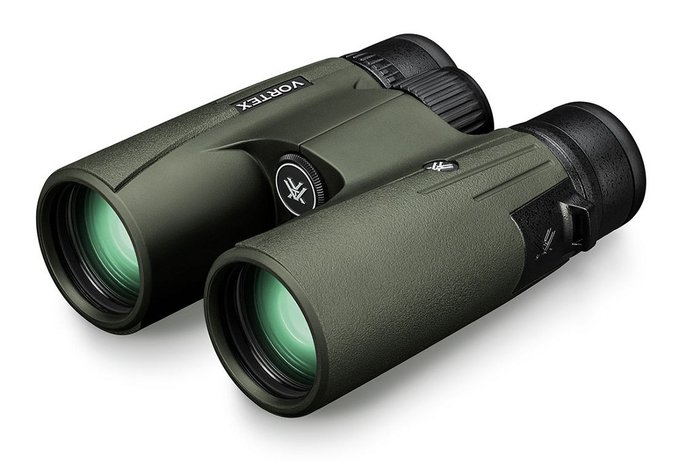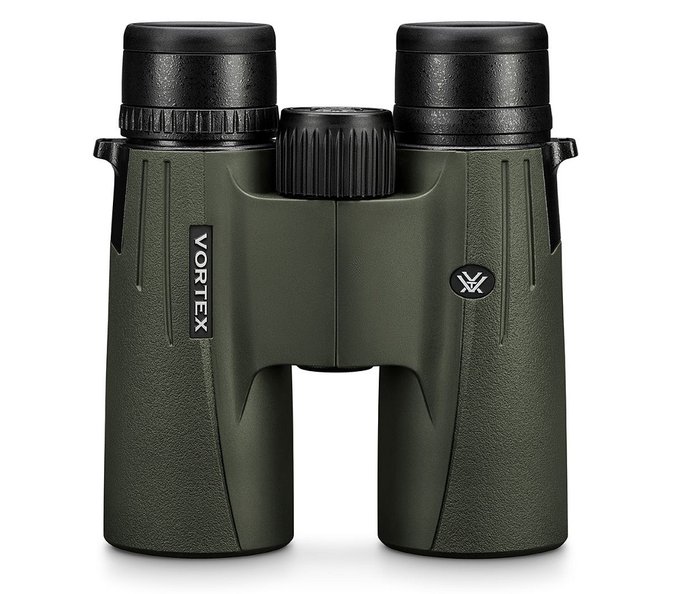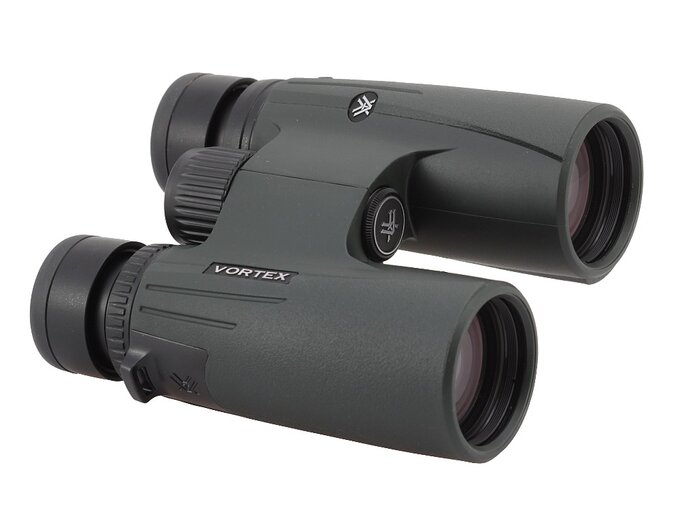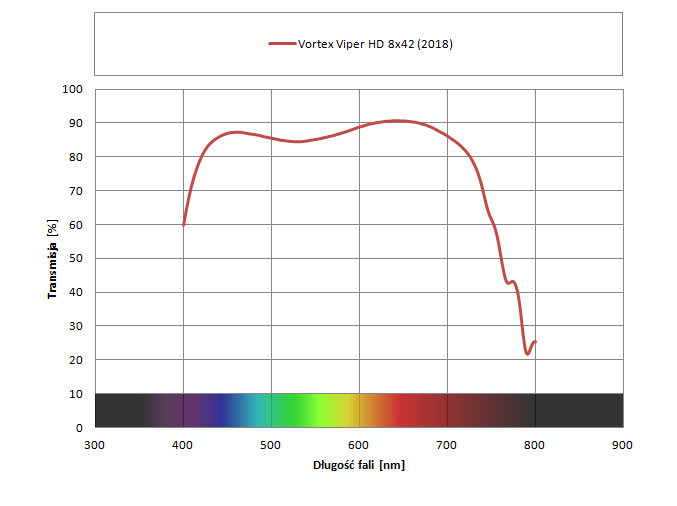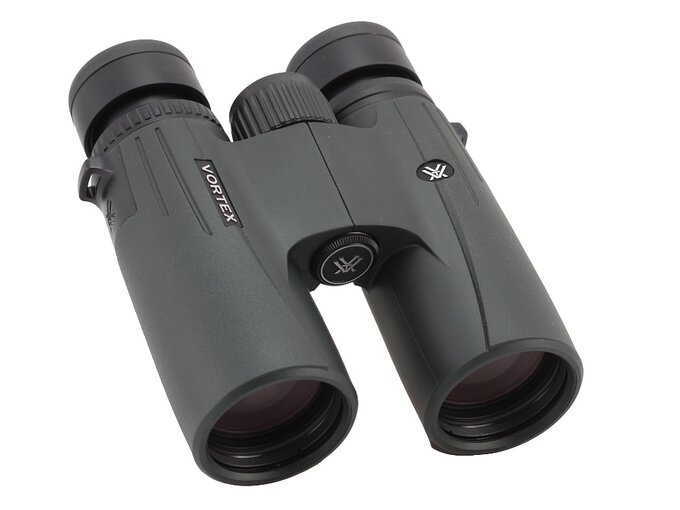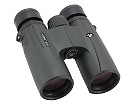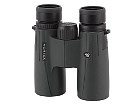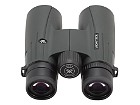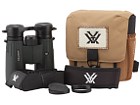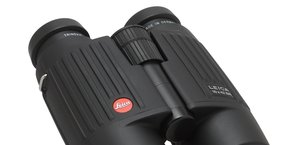The Vortex Viper series was launched in 2006 and its 10×42 representative was one of dark horses of our big 10x42 instruments test.
In 2011 that series got a successor in the form of the Viper HD line and one of binoculars belonging to it,
namely the 10×42 device, we've already tested. I admit we described it in superlatives only.
Year 2018 brought another change – the binoculars got a completely new optical construction and the number of models in the line decreased to four so was limited to the instruments with the following parameters: 8×42, 10×42, 10×50 and12×50.
What about the 8×42 model? We've noticed both positive and negative changes. What's the most important, the field of view increased from 6.6 to 7.8 degrees and finally it befits an 8x instrument. Unfortunately the eye relief decreased from 20 to 17 mm and the minimum focusing distance was lengthened from 1.7 to 2.0 meters. The new model also became a bit heavier. Luckily the producers didn't increase the prices of new models.
The producer boast of low disperison HD glass and HR Fully Multi-Coated layers in the optical construction. Additionally, Schmidt-Pechan prisms feature phase-correction and dielectric coatings. Exterior elements are protected by hydrophobic ArmorTek layers, which are supposed to guard them from scratches, oil, and dirt.
The casing of the binoculars is waterproof and argon-purged. Buyers get in the box with the instrument: a set of caps, a strap, a stylish case and a harness. The binoculars come with a lifetime warranty period.
| Magnification |
Lens diameter |
Angular field of view |
Prisms |
Eye relief |
Weight |
Price |
| 8 |
42 |
137/1000(7.8o) |
BaK-4/roof |
18 mm |
695 g |
2199 PLN |
|
|
| Real front lens diameter |
Left: 42+/-
0.05 mm
Right: 42.05+/-
0.05 mm
|
8 / 8.0 pkt |
| Real magnification |
8.01+/-
0.05x
|
3/3.0 |
| Transmission |
85.2+/-
1%
|
13/25.0 |
| Chromatic aberration |
Slight in the centre, distinct on the edge. |
6.1/10.0 |
| Astigmatism |
Low. |
7.9/10.0 |
| Distortion |
The distance between the first curved line and the field centre compared to the field of vision radius: 39% +\- 3% |
4/10.0 |
| Coma |
Occurs in the distance of about 50% from the field centre and is medium on the edge at the most. |
4.4/10.0 |
| Blurring at the edge of the FOV |
The blur appears in the distance of 77% +\- 3% from the field of vision centre. |
5/10.0 |
| Darkening at the edge the FOV |
Slight. |
4/5.0 |
| Whiteness of the image |
A dip in the transmission curve for green light so images have a delicate orange colouring. |
4/5.0 |
| Collimation |
Perfect. |
5/5.0 |
| Internal reflections |
| Left: |
Right:
|
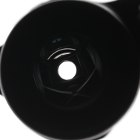 |
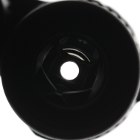 |
Bright arcs near exit pupils. |
3/5.0 |
| Housing |
A solid instrument, comfortable to hold and to look through. Good quality rubber armour that clings well to your hands but it sticks out a bit near objective lenses. Good position of thumb indents. Rubberized eyecups with four detention stops. An inscription on the bridge informs you that the binoculars were made in the Philipines. |
7.5/8.0 |
| Focusing |
Quite big, comfortable central wheel but its resistance we found a tad excessive. Its focus throw amounts to an angle of about 510 degrees. A retractable ring for dioptre correction is situated on the right eyepiece. It moves the outer element. |
4.5/5.0 |
| Tripod |
A quite comfortable tripod access |
3/3.0 |
| Interpupilary distance |
from 54.5 to 74mm
|
5/6.0 |
| Closest focusing distance |
1.95 meters. |
2/2.0 |
| Eyepieces FOV |
Apparent field of view of 65.0 deg (according to the simplified formula) and 59.2 deg (according to the tangent formula). |
14/20.0 |
| Field of view |
Measured by us amounted to 8.12 +\- 0.04 degrees and it was even slightly wider than that stated in the specifications. A good field for this class of equippment. |
7/8.0 |
| Quality of the interior of the barrels |
Inner tubes are ribbed, dark and sensibly matted. The bottom is dark, with an exception of a narrow, a bit too bright rim around the prisms. Clean, we could spot only few specks of dust. |
4.2/5.0 |
| Vignetting |
| Left: |
Right:
|
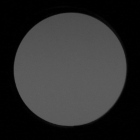 |
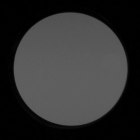 |
OL: 0.99%, OR: 0.50% |
7/8.0 |
| Prisms quality |
Good qualityBaK-4. |
8/8.0 |
| Antireflection coatings |
Green-yellow-ornage on objectives, green-purple on the prisms, green-purple on eyepieces. Low intensity.
|
5/5.0 |
| Warranty [years] |
lifetime |
6/6.0 |
| Final result |
74%
|
140.6 / 190 pkt
|
| Econo result |
|
0pkt. |
Summary
Pros:
- solid and stylish casing,
- wide field of view,
- properly corrected astigmatism,
- good correction of chromatic aberration in the field centre,
- low brightness loss on the edge of the field,
- natural colours of images,
- good quality BaK-4 prisms,
- proper blackening and cleanliness inside the binoculars,
- lifetime warranty.
Cons:
- too hight chromatic aberration on the edge of the field of view.
One glance at our chart with results and the list of pros and cons and you know that the Vortex, tested here, is practically devoid of any weak points. Apart from chromatic aberration on the edge of the field of view all its aberrations are corrected to at least a satisfactory degree.
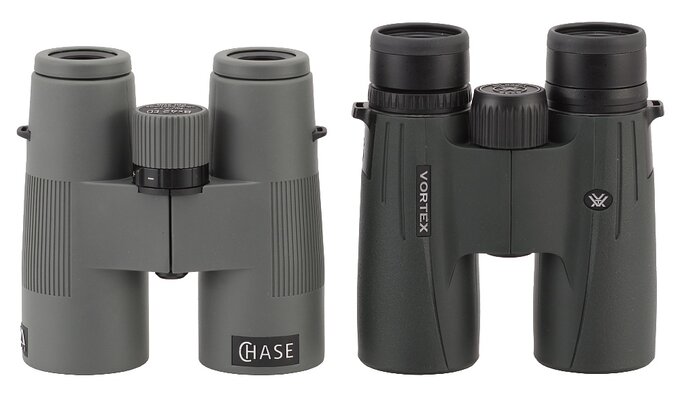
Delta Optical Chase ED 8x42 and Vortex Viper HD 8x42. |
It's worth remembering that the Viper HD 8x42 keeps officially declared parameters exceedingly well; in a case the reality differs a bit from them, it's actually benefitial for the user. The field of view is such a nice surprise, amounting to over 8 degrees and being wider than the official field value stated in specifications.
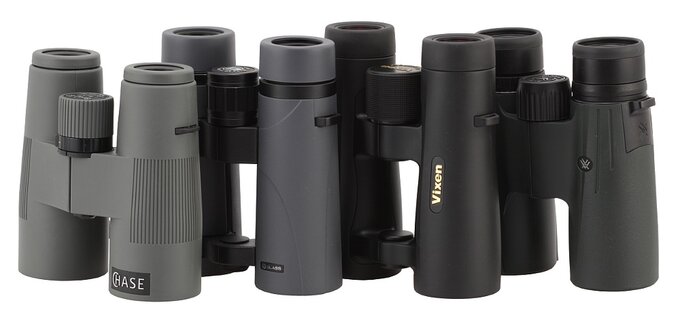
Delta Optical Chase ED 8x42, Bresser Pirsch ED 8x42 PhC, Vixen New Foresta II 8x42 ED DCF and Vortex Viper HD 8x42. |
The final result of the Viper HD 8x42 allows us to place that pair of binoculars somewhere between the results of its 10x50 and 10x42 brothers. It shows the whole series is very even and maintain the same standards.
Still, we think fierce competition might be a certain problem for the Viper – there are a lot of models of binoculars in the 8x42 class so it is really easy to find very solid, direct rivals of the Viper even among models positioned at the same price point which we've already tested. For example the Bushnell Forge 8x42, the Leupold-BX-4 Pro Guide HD 8x42, the Nikon Monarch 7 8x42 or the Olympus PRO 8x42 come to mind.
Of course the results of our test are one thing and your personal comfort during observations conducted with a given pair of binoculars is for you personally is quite another. Every single person has a different visual system and another shape of eye sockets so even the best of test results can't guaratee a given device will be for your personally as comfortable as for other people. Who knows, perhaps out of all other binocluars of this class the Viper HD 8x42 will fit you the best. Anyway, we are spoiled for choice and it's an excellent piece of news – let us finish our test on that optimistic note.
